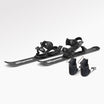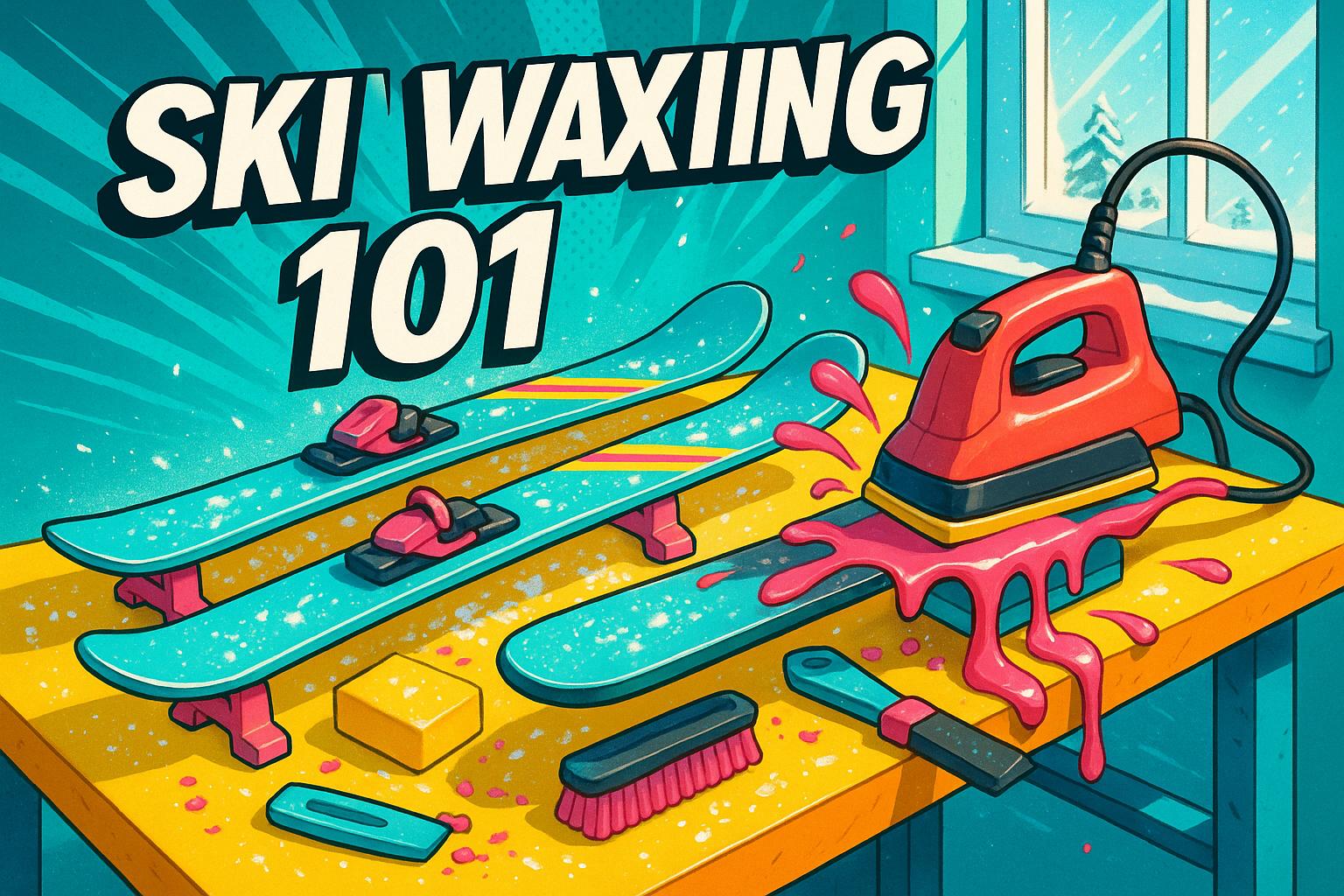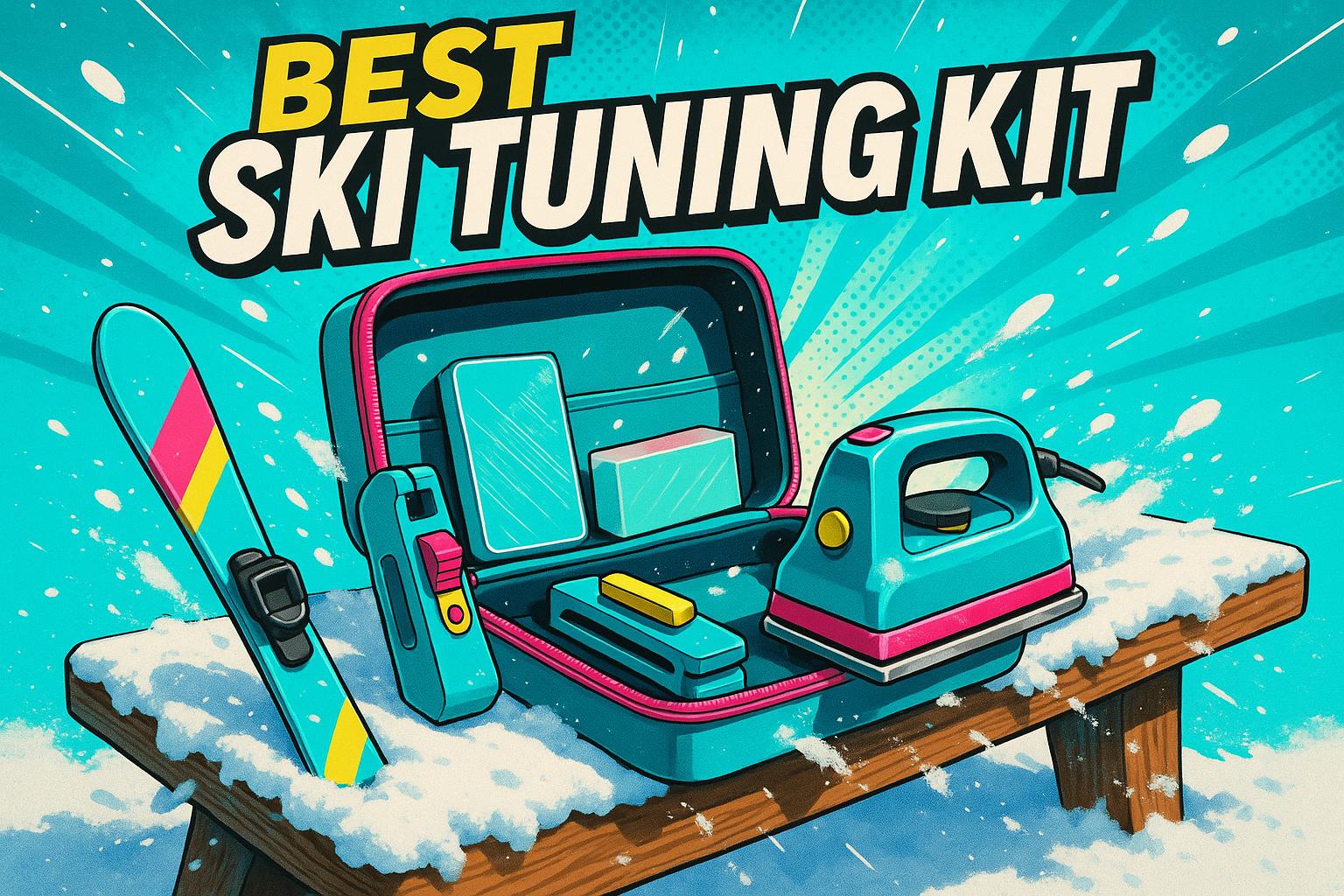When it comes to keeping your ski edges sharp, here’s the quick answer: it depends on how often you ski, the snow conditions, and your skill level. For short skis like Snowfeet Skiblades or Skiskates, maintaining sharp edges is even more important since they rely heavily on edge precision for control and safety.
Key Takeaways:
- Frequent Use: If you ski daily or love aggressive carving, sharpen every 2-3 days.
- Icy Conditions: Hard-packed or icy snow dulls edges faster - sharpen every 3-5 days.
- Powder Days: On softer snow, you can go 7-10 days between sharpenings.
- Skill Level: Beginners need sharp edges for control, while experts may need more frequent tuning due to sharper edge angles (92°+).
- Quick Test: Drag your fingernail along the edge - if it doesn’t catch, it’s time to sharpen.
Short skis like Snowfeet products are easier to maintain due to their compact size, making edge care quicker and less of a hassle. Regular maintenance ensures better grip, smoother turns, and a safer ride. Let’s dive into the details.
How to sharpen your snowboard/ski edges (FAST AND EASY)
What Determines How Often to Sharpen Your Ski Edges
When it comes to keeping your Snowfeet* gear in top shape, the frequency of edge sharpening depends on a few key factors. Every skier's needs are different, and here's why.
How You Use Your Skis
Your skiing habits play a major role in how quickly your edges wear down. If you're hitting the slopes daily, your edges will dull faster than if you're a weekend warrior.
"Edges can and should be maintained each day of riding with a diamond file, think of it like honing a kitchen knife." - Leif Sunde, Denver Sports Lab Proprietor
For those who love aggressive carving or high-speed runs, edge wear happens even faster. This is especially true for Snowfeet* products like the 44 cm Skiskates or 99 cm Skiblades. These shorter skis rely heavily on sharp, precise edges to deliver quick and responsive turns. Regular tuning ensures you're not fighting against dull edges every time you ski.
Snow Conditions
The type of snow you're skiing on has a big impact on how often you should sharpen your edges. Icy or artificial snow grinds down your edges much quicker than soft powder. If you're skiing on hard-packed or icy slopes, plan to sharpen your edges every 3 to 5 days to maintain grip and control. On powdery days, you can stretch that interval to 7 to 10 days.
Skill Level and Edge Angle
Your skill level and the edge angle you prefer also determine how often you need to sharpen. Beginners benefit from regularly maintained edges for better control and confidence. Dull edges can make learning harder - and less safe. Advanced skiers tend to favor sharper, more aggressive edge angles, which offer excellent carving performance but dull more quickly.
Here’s a quick breakdown of edge angles by skill level:
- Beginners: 90° for steady, predictable control
- Intermediate skiers: 91° for versatility across various terrains
- Expert skiers: 92–93° for sharper, more aggressive carving
"If some is good, more is not always better!" - Race Place
For Snowfeet* gear, these small edge angle tweaks can make a noticeable difference. If your skiblades feel like they're sliding out of turns, increasing the edge angle might help. On the flip side, if they feel overly grabby and hard to release from turns, dialing the angle back slightly could solve the issue. Striking the right balance between edge angle, skill level, and snow conditions is key to getting the most out of your Snowfeet* experience.
Sharpening Schedule for Snowfeet* Skiblades and Skiskates

How Often to Sharpen
When it comes to sharpening Snowfeet* edges, it really depends on how often and where you use them. For regular piste skiing, sharpening every other day works best. The compact design of Snowfeet* Skiblades and Skiskates requires sharp edges for those quick turns and precise handling.
Here’s how you can tweak your sharpening routine based on the conditions:
- Icy or hard-packed snow: Edges dull faster, so sharpen more frequently.
- Powder days: You can go longer between sharpening.
- Start of the season: Always begin with freshly sharpened edges to keep things safe and fun.
Not sure if your edges need attention? Try the fingernail test: lightly run your fingernail along the edge. If it catches or scrapes a bit, you’re good to go. If it doesn’t, it’s time for a sharpening session.
This simple routine makes maintaining Snowfeet* gear a breeze.
Why Snowfeet* Products Are Easier to Maintain
One of the best things about Snowfeet* products is how easy they are to maintain compared to traditional skis or snowboards. Their compact size doesn’t just boost performance on the slopes - it also makes upkeep simpler.
Snowfeet* Skiblades are between 65–120 cm long, much shorter than standard skis that usually exceed 150 cm. This means there’s less edge to sharpen, so the process is quicker and less of a hassle.
Their smaller size also makes them easier to handle during maintenance. Whether you’re setting them up on a workbench or just storing them at home, they’re far less cumbersome than traditional skis.
"Snowfeet and Skiskates are compact alternatives to traditional skis." - Snowfeet Team
In short, taking care of your Snowfeet* gear is straightforward and efficient. With less time spent on maintenance, you’ll have more time to enjoy the slopes.
sbb-itb-17ade95
How to Sharpen Short Skis and Skiskates
Sharpening your Snowfeet* at home is easier than you might think. Thanks to their compact size, maintaining Snowfeet* Skiblades and Skiskates takes less time and effort compared to traditional skis.
Tools You'll Need
Having the right tools on hand makes sharpening a breeze. You don’t need a professional setup - just a few key items will do the trick:
- Diamond files: Perfect for polishing and smoothing edges.
- File guides: Help maintain the correct edge angle, usually 88-90 degrees.
- Gummy stone: Removes rust and burrs before sharpening.
- Ski vises: Keep your Snowfeet* stable during the process.
- Cleaning cloths: Essential for wiping down edges to prevent rust.
- Rubber bands or retainers: Keep ski brakes out of the way.
- Small clamp: Handy for added stability.
The compact design of Snowfeet* means you don’t need a large workspace. A sturdy table or standard workbench will do just fine.
Sharpening Steps
Snowfeet* are designed to be low-maintenance, and sharpening them follows a straightforward process:
- Secure your Snowfeet*: Use ski vises to hold them firmly in place. If they have brakes, secure them with rubber bands or retainers.
- Prep the edges: Use a gummy stone to get rid of any rust or burrs. Wet the edges with water for smoother sharpening.
- File the edges: Start with the side edges. Use a file guide to maintain the factory angle (typically 88 degrees). File smoothly from tip to tail. Flip the Snowfeet* and use a base edge file guide to work on the base edges.
- Polish the edges: Finish with a diamond stone for a smooth, polished finish. Lightly round the tip and tail edges with a gummy stone to make turns feel smoother and prevent the edges from grabbing too much on the snow.
"Less work more often is the key to keeping skis running well. You can do a lot of edge work at home if you keep your edges in good shape." - Leif Sunde, Owner of the Denver Sports Lab
For the best results, work on your edges before waxing the bases. And since Snowfeet* have shorter edges, the whole process takes less time compared to traditional skis.
Maintenance Tips
A little regular care goes a long way in keeping your Snowfeet* in top shape. Here are some easy tips to keep them performing their best:
- Dry after each use: Always dry your Snowfeet* thoroughly after skiing to prevent rust.
- Check for burrs: Run your finger along the edges to feel for burrs. If you find any, use a medium diamond stone to smooth them out.
- Quick sharpness test: Drag a fingernail across the edge. If it scrapes off some nail, the edge is sharp enough.
- Hone regularly: Use a fine diamond stone after every ski day to keep edges sharp - just like honing a kitchen knife.
"Think of it as honing a blade such as a kitchen knife." - Leif Sunde, Founder of the Denver Sports Lab
- Store properly: Keep your Snowfeet* in a dry, cool place. At the end of the season, apply a light coat of oil or wax to protect the edges from rust during storage.
Thanks to their small size, storing Snowfeet* is much simpler than dealing with long skis. And with regular maintenance - like removing rust and burrs using a gummy or fine diamond stone - you can keep them in excellent condition with minimal effort.
Snowfeet* vs. Long Skis and Snowboards: Maintenance Comparison
When it comes to keeping your gear in top shape, Snowfeet* products have a clear edge over traditional long skis and snowboards. Thanks to their compact size, maintaining them is not only easier but also more practical, no matter how often you hit the slopes. Let’s break down why Snowfeet* shines in convenience and upkeep.
Comparison Table: Snowfeet* vs. Long Ski Gear
| Factor | Snowfeet* Products | Traditional Long Skis | Snowboards |
|---|---|---|---|
| Edge Length | 26–47 inches | 59–79 inches | 55–65 inches |
| Required Workspace | Standard table | Large workbench | Large workbench |
| Storage Space | Fits in a backpack | Requires ski rack/bag | Requires board bag |
| Portability | Excellent | Poor | Fair |
| Edge Angle | 88–90° | 88–90° | 89–90° |
Why Snowfeet* Stands Out
Snowfeet* offers a host of maintenance perks that make them a standout choice. Their smaller size, ranging from 26 to 47 inches, is a big win compared to the 59 to 79 inches you’d deal with for traditional skis. This shorter length means less effort when it comes to sharpening and tuning edges.
Another big plus? You don’t need a massive, specialized workspace. Unlike traditional skis and snowboards that often require a large workbench or even professional tuning services, Snowfeet* gear can be maintained on any sturdy table. This eliminates the hassle of awkward setups and makes the process much more comfortable.
What’s more, the metal edges on Snowfeet* are the same as those on regular skis and snowboards. That means the process of tuning them is just as straightforward, even for beginners. If you're new to DIY gear maintenance, Snowfeet* makes it easy to dive in with confidence.
Storage and portability are also game-changers. Snowfeet* gear’s compact design fits neatly into a backpack, so you don’t need bulky racks or bags. This not only simplifies transportation but also encourages regular maintenance since it’s so easy to access and handle. Spot an issue with the edges? No problem - quick fixes are always within reach.
Finally, Snowfeet* gear isn’t limited to just groomed slopes. They perform well across various terrains, from ski slopes to hiking trails. This versatility makes their low-maintenance design even more appealing, ensuring you’re always ready for your next adventure.
Get the Most from Your Snowfeet* with Proper Edge Care
Keeping your Snowfeet* in top shape doesn’t just make them last longer - it makes every run smoother, safer, and way more fun. And the best part? Maintaining them is quick and easy, especially compared to traditional long skis that often need professional tuning and more time-intensive care.
With Snowfeet*, staying on top of edge maintenance is a breeze. Regular care means better control, improved safety, and a more enjoyable ride, whether you're cruising groomed trails or tackling backcountry powder. Sharp, well-maintained edges let you push your skills and try new moves with confidence.
Here’s the simple routine: after each day on the slopes, dry the edges to prevent rust. Check for any burrs or damage regularly, and sharpen them whenever performance starts to dip - or at least before the season kicks off. Thanks to Snowfeet’s compact design, these tasks take just a few minutes, not hours.
"These skiblades are so much fun and easy to control. Never going back to regular skis." – Andrew B.
Whether you're hitting the park with the 17-inch Skiskates or exploring the whole mountain with the 47-inch Skiblades, keeping your edges in shape ensures every run feels like your best. Plus, the portable design means less time in the shop and more time shredding the slopes.
FAQs
How can I tell if my ski edges need sharpening?
You can figure out if your ski edges need sharpening with a quick fingernail test. Just drag your fingernail lightly along the edge. If it doesn’t shave off a tiny bit of your nail, chances are the edge is dull. Dull edges can also feel rough or look gray and worn down, especially near the base.
Another method is the side slip test while you’re out on the slopes. If you’re sliding around on hard-packed snow or ice and can’t seem to hold your grip, it might be time to give those edges some love. Sharp edges are key for better control, safety, and overall performance - this is especially true for Snowfeet* gear like Skiblades and Skiskates, which are all about precision and making your time on the slopes a blast.
What tools do I need to sharpen my Snowfeet Skiblades at home, and how do I use them properly?
To keep your Snowfeet Skiblades in top shape, you’ll need a few basic tools: a fine-grit ceramic stone or file (something like the EdgeTune Pro II works great), a diamond stone for polishing, and, if you want to be extra precise, an edge guide to maintain the correct angle - usually 88° or 90°. These tools are key to ensuring your edges stay sharp, giving you better control and performance on the slopes.
Here’s how you do it:
- Start by removing any rust or burrs with a gummy stone or a second-cut file. This preps the edges for sharpening.
- Next, take your ceramic stone or file and carefully run it along the edges at the recommended angle to sharpen them.
- Finally, use the diamond stone to polish and smooth the edges. This step gives them a clean, professional finish.
Make sure your skiblades are secured in a stable position while you’re working. It’s not just about precision - it’s about safety too.
One of the perks of Snowfeet gear is that it’s easier to maintain compared to traditional skis or snowboards, which often need more frequent care. With regular sharpening, your Snowfeet Skiblades will stay high-performing and ready for action, whether you’re a seasoned rider or just starting out.
Why is maintaining Snowfeet gear simpler compared to traditional skis and snowboards?
Maintaining Snowfeet gear is a breeze compared to traditional skis or snowboards. Thanks to their smaller size and lighter weight, they don’t need the constant attention that larger equipment demands. Forget about regular waxing, edge tuning, or trips to a pro shop - keeping Snowfeet in good condition is as simple as it gets. A quick wipe to clear off dirt and snow, plus the occasional waxing, is usually all it takes.
Their compact design and durable materials mean they’re less likely to get damaged, cutting down on repairs and maintenance time. This makes them a great choice for beginners or casual winter adventurers who’d rather hit the slopes than fuss over gear. And here’s a bonus: the low maintenance needs of Snowfeet gear can save you some serious cash compared to the upkeep costs of traditional skis or snowboards. More fun, less hassle - what’s not to love?


































Leave a comment
This site is protected by hCaptcha and the hCaptcha Privacy Policy and Terms of Service apply.